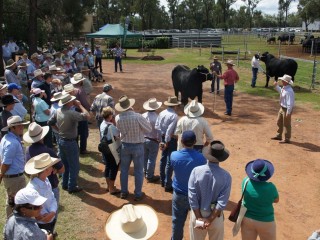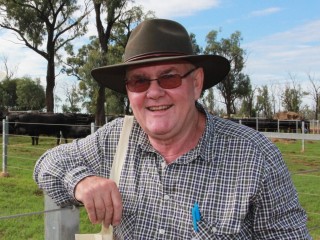 As July draws to a close, eastern Australia’s traditional spring bull selling season kicks-in, with a condensed three-month window of activity when more than 11,000 stud and herd bulls will change hands through auction from Victoria to Central Queensland.
As July draws to a close, eastern Australia’s traditional spring bull selling season kicks-in, with a condensed three-month window of activity when more than 11,000 stud and herd bulls will change hands through auction from Victoria to Central Queensland.
So what do the prospects hold for the 2011 bull buying season?
By normal conventions, it’s a complex market dynamic this year, in Beef Central’s opinion.
On one side there are the lingering effects of the live export market closure. In the far north, that means direct financial impact on beef producers through lack of practical market options, and cash flow. That may inevitably impact on their spending power and bidding enthusiasm when it comes to recruiting bull replacements, regardless of breed, in coming months.
Further south, the impact of the Indonesian market closure has been more psychological, rather than financial, but uncertainty may still have a bearing on bull buying patterns in some areas.
The overall flatness of export and domestic beef markets may also be reflected in bull buyer mood this year. Even salvage value – the trade-in price for used bulls at the meatworks – has declined. When manufacturing beef prices were at their peak some years ago, used herd bulls made $1000-$1100 at the meatworks, giving buyers a handy cash start when they entered the fray bidding for replacements at their preferred sale.
On the flip-side, there are some obvious positives to be seen this year.
The once-in-a-generation season across much of Eastern Australia must underpin bidding confidence in buyers’ minds. Nothing curbs bull bidding enthusiasm more than the thought of taking new purchases home to an eaten-out breeder paddock, and little immediate prospect of rain.
Several industry stakeholders contacted by Beef Central this week also pointed to the general trend towards herd rebuilding, after earlier drought years. Given the abundant feed on hand, heifer retention and holding on to older breeders for an extra year to land an extra calf before liquidating them will be more common. That means higher bull requirements.
Barring a return to drought, MLA anticipates the national beef herd will grow by about 1.1 million head over the next two years, to about 28.5 million head. If it is assumed that one third of that figure represents additional breeders, at a bull mating ratio of 3pc, that would represent a requirement for an additional 11,000 bulls in service.
On a state-by-state basis, herd growth is expected across all the eastern states in 2011 and 2012, with the greatest expansion in northern NSW, Queensland and the Northern Territory.
While numbers for the southern states (Victoria, South Australia and Tasmania) will still be well below their 2004-05 peaks, some herd growth is expected, as producers look to capitalise on better pasture reserves. Western Australia, still under the effects of drought, may be slower to start to rebuild.
Today and tomorrow, Beef Central presents a summary of some of the issues and trends likely to be seen in the 2011 replacement bull market, seeking observations from a variety of industry stakeholders.
Thirst for more data
 The first of these is respected consultant cattle geneticist Don Nicol, who has worked widely across all parts of Australia with both tropically adapted and temperate breeds over the past 30 years through his Breedlink business.
The first of these is respected consultant cattle geneticist Don Nicol, who has worked widely across all parts of Australia with both tropically adapted and temperate breeds over the past 30 years through his Breedlink business.
He sees 2011 as shaping up as an interesting bull selling season, for several reasons.
“Over the past few years there has been an increasing penetration of non-Indicus sire breeds like Angus and Charolais in northern regions of the continent,” he said.
“More producers in those areas have been thinking about moving from Brahman-only herds, based on live export supply, to other, broader market options. The events of the past three months are only likely to exacerbate that trend,” he said.
“The Asian live export market has traditionally taken high-grade Brahman cattle only, but increasingly, feedlots in importing countries have accepted a wide range of crossbreds, and are happy with their performance.”
Mr Nicol said another important development was the advent of the new polled gene test for Indicus breeds.
A homozygous (PP) polled bull with two copies of the dominant poll form of the gene will give a high percentage (up to 100pc) polled progeny out of horned cows, whereas a heterozygous (PH) polled bull with only one copy of the gene will produce around 50pc polled progeny out of horned cows.
If producers started focussing more on polled cattle, there should be a clear premium for the homozygous poll in the marketplace, he said.
While there had been a general premium paid for polled cattle in recent times, the ability to identify those homozygous cattle was ‘very significant’, and the benefits would flow through in better animal welfare and human safety outcomes, more efficient transport with less bruising and other attractions.
“The extra value is there, in animals identified as homozygous polled. But will the market respond to it in sales this year? I would say they would, because they are worth a lot to the industry,” Mr Nicol said.
“With the heightened discussion around animal welfare in the north, the Beef CRC’s poll gene DNA test comes into focus for Brahman, Droughtmasters and Santa Gertrudis breeders wanting to breed the horns off genetically, to eliminate dehorning over time.”
“That suggests to me that all other things being equal, a PP homozygous polled bull should receive a premium price in the marketplace. It could be $5000 or more for a stud bull and hundreds of dollars for a PP tested commercial herd bull,” he said.
Whether distinctions of that size are apparent in the 2011 Brahman bull market is another thing, but the move to polled Brahman breeding would continue, and those homozygous animals would be the key.
The polled gene test was only launched as a trial in August last year, but forward-thinking polled Brahman breeders would be likely to define their ‘PP’ bulls in catalogues this sale season.
Scanning adds information
In southern Taurus breeds, Mr Nicol sees a continuing trend to younger bulls, but for pragmatic reasons, buyers were still looking for herd bull replacements at least 18-24 months of age.
“The trend in a breed like Angus is to continue to pursue carcase characteristics. Scanning of young bulls and heifers for IMF and eye muscle area was continuing to grow at a high rate.
“It’s been a very good year, seasonally, so the quality of scans and the reliability of that information will be higher this year,” he said.
Young bulls in leaner condition, where there was very little difference in external fat between animals, did not provide as accurate information for marbling.
“This year’s big season will provide greater distinction, and for good genetic estimates, you need that variety in the scanning process,” he said.
Increasingly, Angus catalogues were showing more scan information for IMF and EMA, as well as BreedPlan data and the Angus HD50 gene marker test released last year, providing much greater depth of data.
“With a general trend to shorter days-on-feed in the feedlot industry to rein-in costs, it brings the traits of marbling and carcase yield percentage into higher focus for commercial bull buyers, to maintain our competitiveness in the export markets for high quality beef,” Mr Nicol said.
Most southern breeders were applying the HD50 test on young animals that had low levels and accuracy of EBV information due to their age. Given the extent of yearling joinings in southern Australia, bulls and heifers at 12-15 months had only limited information, and it was here that HD50 could provide the best ‘bang for the buck’ in building better genetic estimates.
“For yearling-joining herds, the 50K chip MVPs boosts the information on these young replacement animals especially for the calving ease and carcase traits in yearling bulls. With the Angus breed now running monthly runs of Breedplan , the 50K information on an animal is integrated quickly into the EBVs, so the breeder has all the information to make better selections on these young animals,” Mr Nicol said.
Through the accumulation of Breedplan, scanning and HD50 test data, Angus commercial breeders could more confidently buy a bull to aim at whatever market segment or environment they chose, he said.
“The profitability of the genetics is improving all the time, through selection pressure, and as a result, the commercial bull buyer is getting a better deal.”
Tomorrow, Beef Central canvasses the opinions of agents, breed representatives and others engaged in the bull marketing process.
-
Beef Central now includes a handy 2011 sales and events calendar for the six largest beef breeds, representing about 85pc of all bulls sold through the auction system across the nation. Other breeds will be added as they become available. Go to the ‘production’ page on the navigation bar and look for the breed references, or click here to go straight to the page
